Crawford Sherman tracked tractor (UK)
History the Crawford-Sherman project began in 1947. At that time, RH Crawford & Sons, an agricultural company founded by Robert Crawford, was operating in Lincolnshire, British. One of the areas of her activity was the preparation of virgin lands for use. Using several tractors, self-propelled steam winches and plows, Mr. Crawford and his colleagues plowed the land to great depths, after which new fields could be put into operation. The company took orders from public and private structures, and made a significant contribution to the food security of the country.
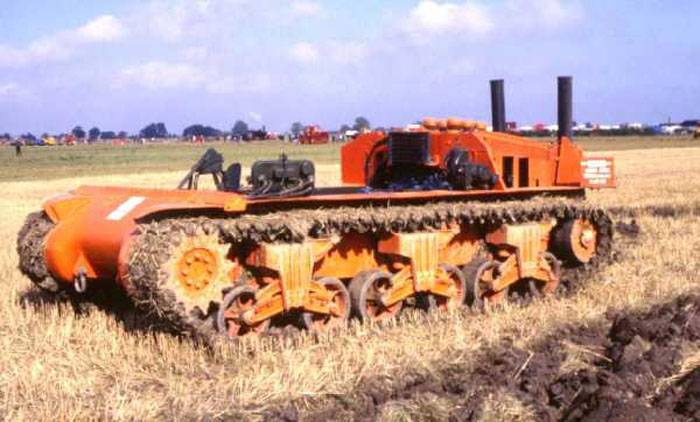
Tractor Crawford Sherman after restoration. Photo Web.inter.nl.net/users/spoelstra
In the second half of the forties, the company faced a serious problem: its fleet of equipment mainly consisted of old samples built many years ago. The existing steam tractors did not fully correspond to the tasks to be solved, and moreover, they managed to work out a fair amount of the resource. In the near future, the company should update the fleet of vehicles. Otherwise, she risked being left without the necessary machines and, as a result, losing orders.
In 1947, R. Crawford found an interesting way to replace outdated equipment, and with a certain increase in characteristics and potential. After the end of World War II, the British army, as well as the armed forces of several other countries, began to sell the more unnecessary combat vehicles. Together with other equipment, it offered customers medium-sized tanks M4A2 Sherman of American design. R. Crawford appreciated such a proposal and found it acceptable. Soon came the contract for the supply of a serial tank.
In accordance with a military agreement, RH Crawford & Sons received one Sherman medium tank. Before handing over to the customer, the seller removed the standard turret, weapons and some other military equipment from the vehicle. The cost of such a contract was only £ 350 - not entirely for nothing, but not too expensive for a combat vehicle with significant resource residues.
As the new owner of the tank and the tractor developer at its base later told, the combat vehicle was released no later than mid 1942 of the year and had a very interesting biography. So, in the fall of 1942, she participated in the Second Battle of El Alamein. This tank was in one of the units that developed the offensive in North Africa and contributed to the victory in this theater of operations. However, the specific data on the combat path of the tank purchased was still unknown.
Having received the ordered tank chassis, R. Crawford and the staff began its restructuring. Not all features of the combat vehicle corresponded to its new role, and therefore part of the units should have been removed, while others were planned to be replaced. Others could be left and used for their intended purpose. As a result, the new tracked tractor retained a certain similarity with the base military machine, but at the same time received the most noticeable differences. In addition, such a machine had minimal external resemblance to other tractors of the time.
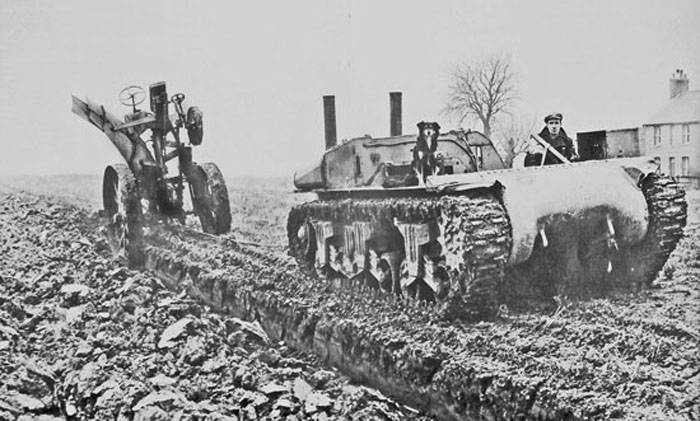
Tractor at work. Probably the photo was taken at the beginning of 50's. Photo Farmcollector.com
The agricultural company considered that the existing tank was too heavy for solving new tasks. This led to a noticeable processing of the hull. The chassis has lost frontal and aft armor, as well as the entire upper part of the body, rising above the fences. In this case, it was decided to retain the characteristic cast transmission housing, which served as the lower frontal part. The lower part of the case with attachments for the undercarriage elements was not finalized. The hull was left open at the top, although the stern engine compartment was covered with a light casing, vaguely similar to the armor of the base Sherman.
It is curious that the removed parts of the case also brought some benefit. More unnecessary armor plates sold to one of the metallurgical enterprises as recycled materials. Perhaps, the money raised for them to some extent simplified the subsequent construction of the tractor.

Front view. Frontal detail clearly indicates the origin of the chassis. Frame from d / f Classic Plant
The layout of the case has not actually changed, but the removal of the upper box affected the composition of the internal units. In front of the car, directly under the cast casing, there were transmission elements. Immediately after them put a couple of jobs crew. The central part of the hull, which previously contained the fighting compartment, now served only to accommodate the longitudinal propeller shaft, which reached the aft engine compartment.
The new tractor has retained a full-time power plant. At the rear of the hull, the General Motors Model 6046 system was left, which included a pair of 6-71 diesel engines with a total horsepower 375. With the help of a longitudinal driveshaft, power was transmitted to the front five-speed transmission, which distributed it between two driving wheels. Taking into account the peculiarities of future operation, the exhaust system has been reworked. In order not to worsen the already difficult working conditions for the operator of the towed plow, a pair of vertical exhaust pipes of sufficient height were installed at the rear of the hull.
The suspension, built on the basis of carts with suspension type VVSS, was fully preserved. Each such trolley was equipped with a pair of road wheels and one supporting roller. The role of the elastic element of the suspension was played by vertical springs. On each board saved three carts. In front of the hull, large drive wheels of the pinching gear were placed, while the guide wheels and the track tensioning mechanism remained in the stern.
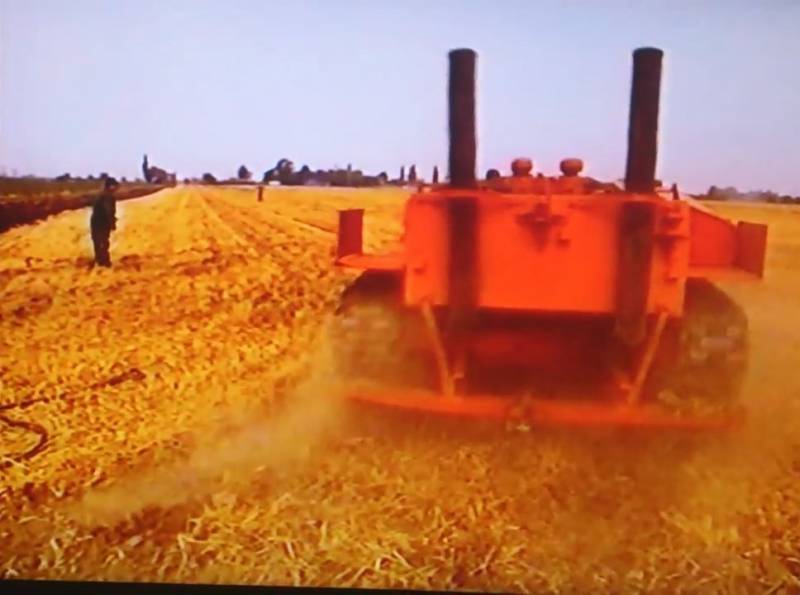
View of the stern. The tank chassis received new exhaust pipes and towing equipment. Frame from d / f Classic Plant
When rebuilding a tank into a tractor, the ergonomics of the habitable compartment changed in a certain way. Instead of a closed management compartment, a simplified cab was used, without a roof or glazing. In front of the case, on the sides of the propeller shaft and transmission, set a couple of the simplest seats. In front of the left were the control devices. Controls and dashboard are not altered. However, R. Crawford and his staff had to come up with new ways of attaching them, since previously some devices were connected to the sides or forehead of the case.
The new tractor was designed to work with plows and other agricultural equipment, and therefore received new devices. So, at the stern of the hull, a frame structure was fixed with a transverse beam placed just above ground level. At the last set the simplest hitch for fastening cables. Also, this or that equipment could be towed using similar devices on the engine cover.
Saving part of the housing units when removing other devices allowed to a certain extent to reduce the dimensions of the machine, as well as drastically reduce its mass. In size, the tractor R. Crawford almost matched the original tank. It had a length of less than 5,9 m with a width of 2,6 m and a height of less than 2 m. Curb weight was reduced to 20 t, which made it possible to obtain the required traction characteristics with an acceptable load on the ground. Driving characteristics of the car almost did not change. However, during the new work the tractor would not have to develop the maximum speed or overcome major obstacles.
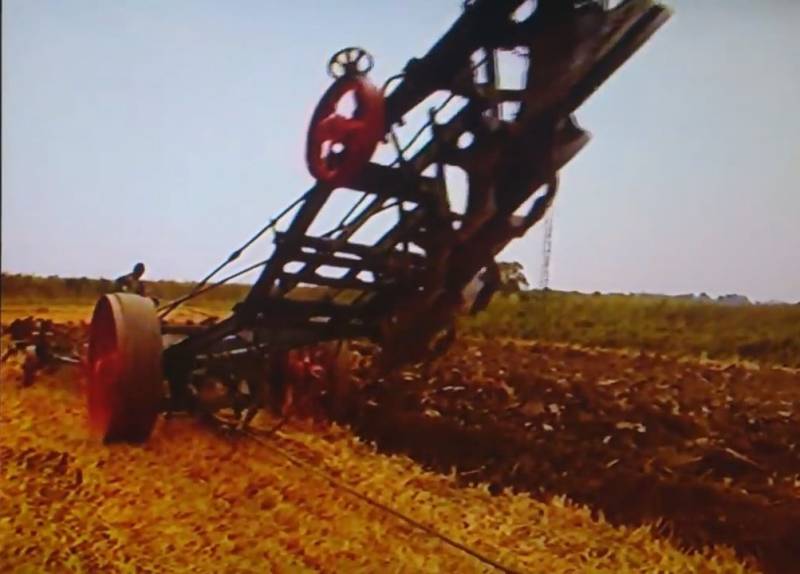
Balancing plow during operation. One of the frames is raised, the other plows the ground. Frame from d / f Classic Plant
Already during perestroika, the new tractor tank received a bright red color. Also on the side shield of the engine casing there were white inscriptions stating that the unusual car belonged to RH Crawford & Sons.
As far as is known, the new tracked tractor did not have its own name, which allowed it to be confidently distinguished from other vehicles of similar purpose. However, over time, this problem was solved. Now a curious sample is often referred to as Crawford Sherman - by the name of the creator and the name of the base machine.
Two plows were offered for use with the Crawford-Sherman tractor, which were then actively used by the operating company. The first of these was intended for plowing the ground to a depth of 3 feet and was originally used with the Fowler self-propelled winch. The existing balance plow with a pair of single-body coulters did not need any modifications, and could be used as is. In this case, instead of a steam winch, he now had to tow a tractor.
The main part of the tasks was planned to be solved with the help of a multi-body balance plow, also manufactured by Fowler. The basis of this product was a light front wheel drive, on which were attached two frames with four openers each. On both frames there were jobs for an operator who could control the work of the plow and change its parameters. Like the other balance plow, the larger system could be towed behind the tractor with a cable.
The restructuring of the purchased tank into a promising tracked tractor ended in the same 1947 year. Without losing time, R. Crawford brought his novelty on the field and tested in real conditions. The car showed itself well, and it was put into full operation. Soon the best methods of its use were determined, which allowed to get maximum performance with minimum fuel consumption and time. Due to this, in particular, it was possible to abandon the previously used methods of using a balance plow with a pair of self-propelled winches standing at the edges of the field.
Towing a plow, the Crawford Sherman tractor moved in second gear at a speed of no more than 6-7 miles per hour (9-11 km / h). Having reached the opposite edge of the field, the crew disconnected the towing cable, turned the plow on the front end, lowered the other frame with the coulters, and then turned the car around and attached the second cable. This made it possible to quickly and simply start moving in the opposite direction. Both plows, designed to work with a crawler tractor, differed in their characteristics, but had a similar design. Therefore, working with them was the same.
Using such a technique, a single tracked tractor could plow up from a working day from 10 to 20 acres - 4-8 ha or 40,5-81 thousand square meters. On average, such work took 65 gallons of fuel (almost 300 l). Thus, in terms of performance, the former tank was at least not inferior to other agricultural equipment of the time. And if you take into account the minimum cost of the base machine and not the most expensive restructuring, then it exceeded it in general terms.
According to known data, the only tractor "Crawford Sherman" completely covered the needs of RH Crawford & Sons in such machines. New samples of such equipment were no longer built. The tractor was operated for a long time for one purpose or another. Depending on the specifics of new orders, it could work on virgin soil and prepare it for use, plow already developed fields or perform the functions of a tractor with high performance. In the post-war period Great Britain experienced certain difficulties with agricultural machinery, and therefore even one "tank-tractor" could make a significant contribution to the country's food security.
As far as is known, the active exploitation of the tractor lasted for about a decade. In 1957, the car, which had already served in the army, developed its resource and could no longer solve the tasks. To the delight of lovers of unique technology, R. Crawford did not sell the tractor for scrap or dispose of it on its own. For several years he stood idle, but no one was going to get rid of him.
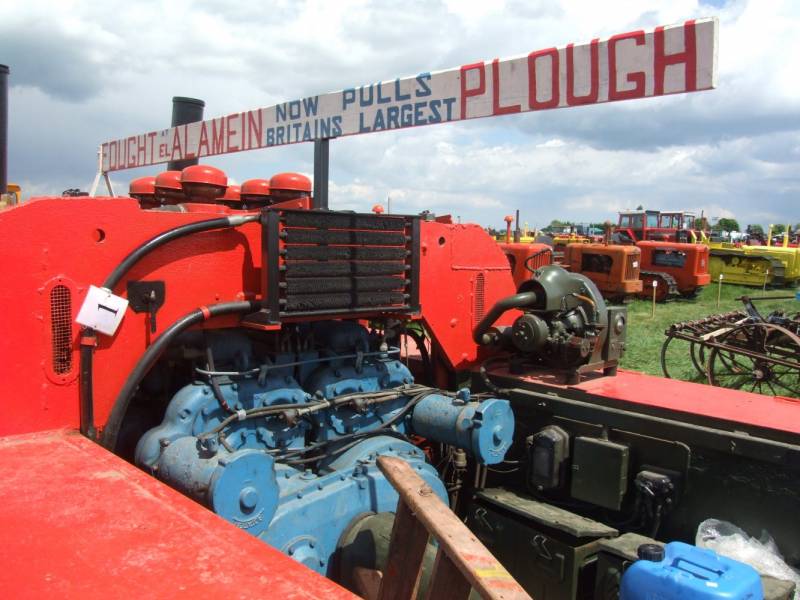
View of the interior of the body. Also visible is a sign talking about the combat and labor exploits of the machine. Photo Hmvf.co.uk
In 1984, Robert Crawford Jr., the son of its founder and creator of an unusual tractor, became the head of RH Crawford & Sons. In accordance with one of the first decisions of the new leader, the Crawford Sherman tractor went to be repaired and restored. The car was again on the move and restored its previous spectacular appearance. In addition, the restorers have added a new part to the tractor. A plate appeared on the engine cover with a loud reminder: "He fought at El Alamein, and now pulls the heaviest plow in Britain."
The reconstructed tracked tractor was included in the exposition of the private Crawford Museum, which collected many interesting samples of agricultural and special equipment of bygone days. The car on the basis of "Sherman" after repair can move independently, and because of this it is often attracted to participate in various demonstration events. The unique exhibit has not been used for a long time for its intended purpose, but it is still able to show its capabilities to the viewers.
It should be noted, however, that the Crawford Sherman tractor was not unique or the only one of its kind. In the second half of the forties, the armies of several countries were actively getting rid of surplus military equipment, and agricultural and other civilian structures bought them out, due to which they restored their parks. However, the RH Crawford & Sons tractor has an important difference from its analogues. It has not been disposed of, has survived to our time and remains on the move. Unlike many decommissioned, butchered or simply abandoned cars, it is able to visually demonstrate the history of post-war British agriculture and convey the spirit of its era.
On the materials of the sites:
https://farmcollector.com/
http://tractors.wikia.com/
http://classicmachinery.net/
http://web.inter.nl.net/users/spoelstra/
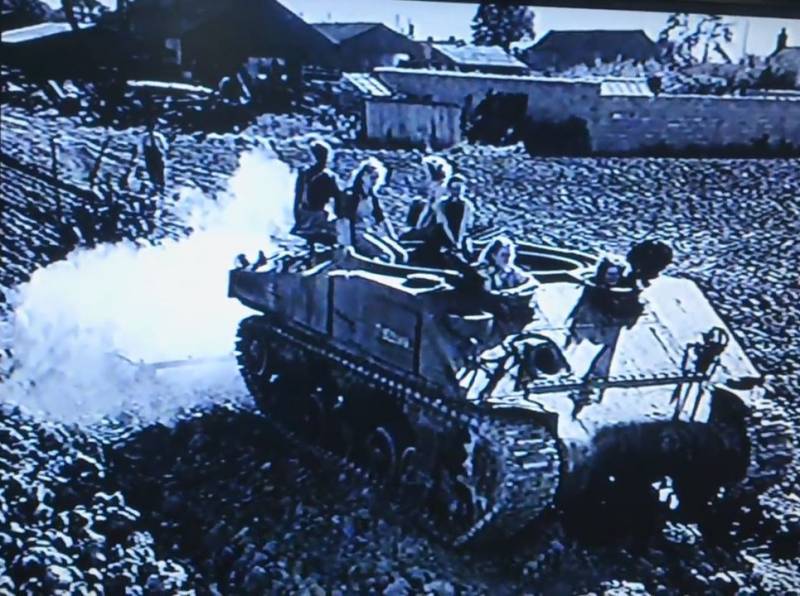
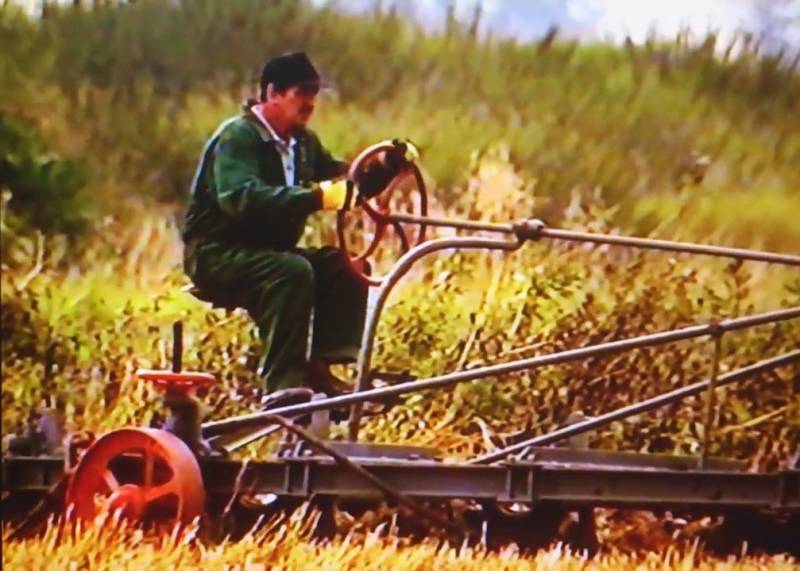
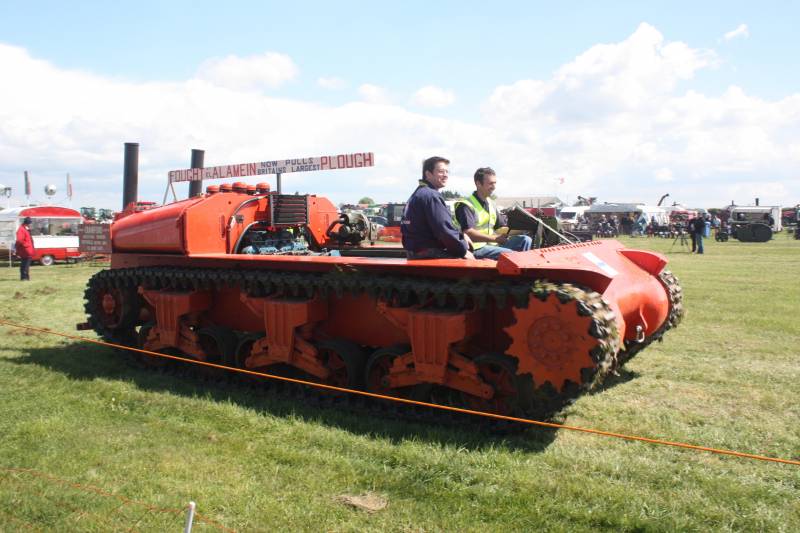
Information